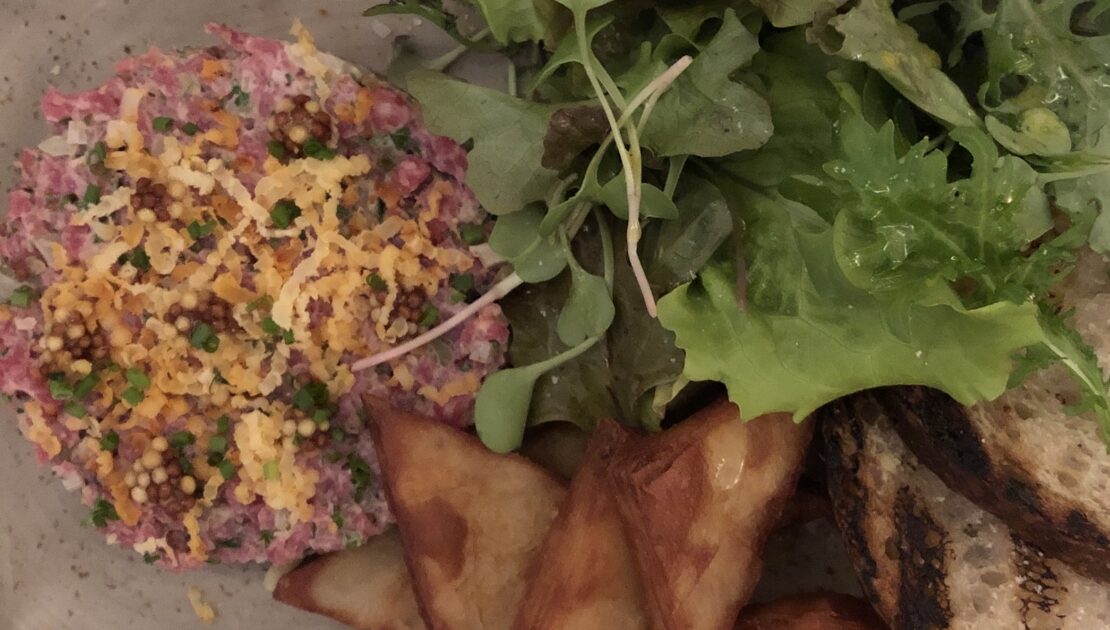Classic Steak Tartare

Here’s how to make classic steak tartare at home and make it taste just as fabulous as any French bistro.
by Erin
One of my favourite dishes in the world is steak tartare.
Almost anytime I go out to eat, if it’s on the menu, I order it. For a while, I was thinking about writing an opinion piece on the best classic steak tartare in Toronto. I had a great time researching.
Years ago, when I was the sommelier at a private club in Toronto, I worked with a terrific Chef, who became a very dear friend. Originally from England, Andrew spent nearly 50 years in the industry. Classically trained, of course, he worked at the Savoy and cooked for royalty (he had hand-written letters of thanks from the Royal Family framed in his office.)
Andrew taught me how to shuck an oyster, properly fry a French fry, and, make addictive steak tartare. All the important thing in life.
Below is the recipe, which really is more of an assemblage. If you’ve never made tartare before, and feel more secure to follow the steps exactly as written, rest assured you will get spectacular results with this combination of flavours.
However, the nice thing about steak tartare is that it’s so highly personal that other than the beef, you can add, remove, or adjust all other ingredients as you see fit.
I’m a big fan of briny capers, cornichon, and loads of Worcestershire sauce. Anchovies, meh, not so much. So the hairy little fish never make it into my version.But I’ve nobly left them in this recipe because so many people (including Andrew) love them.
Please remember to add ingredients gradually, taste as you go, and add more of this and that if you think it’s needed.

Classic steak tartare
Total time: About 30-45 minutes, depending on how fast you dice and slice
Serves: 4 people as a meal, 8-10 as a snack
Chef level: Beginner +
Ingredients:
- 4 anchovies, minced
- 1 egg yolk, lightly beaten
- 2 Tbsp Worcestershire sauce
- 1 oz. cognac, optional
- 2 Tbsp Dijon mustard
- Tabasco sauce, to taste
- 1 tenderloin, minced with a sharp knife (as fine or coarse as you prefer)
- 2 Tbsp cornichon, diced
- 4 Tbsp capers
- 2 tsp extra virgin olive oil
- 2 Tbsp shallot, diced
- 1/4 cup chopped parsley or chives, optional
- S&P to taste
- 4 large egg yolks, left intact, optional
Directions:
- In a large bowl, lightly mix lightly mix anchovies through Tabasco.
- In a separate bowl, gently combine, but do not overwork, beef through S&P.
- Pour anchovy mixture into the beef mixture and stir gently to combine.
- Shape into 4 patties and carefully top with whole egg yolks. Serve alongside frites for a true bistro experience, or, for a healthier, but far less fun option, a tossed green salad.

Wine Pairing
When we were dining on steak tartare in a bistro in Paris last year, we happily sipped on the “Vin Rouge” they recommended to go with it. I find that beef tenderloin, as lean as it is, comes across as rich when served raw. A wine with a nice backbone of acid will help lighten it up. Also, because of the vinegary capers and cornichon and touch of spice from the Tabasco, a wine with lower tannin is a good idea.
Personally, I like classic Beaujolais as a pairing. It hits all the right notes of juicy, energetic and easy drinking. But if you want to get fancy, I wouldn’t say no to a mid-weight rosé sparkling wine.
This blog was first published in 2012 and has been updated in 2020.
